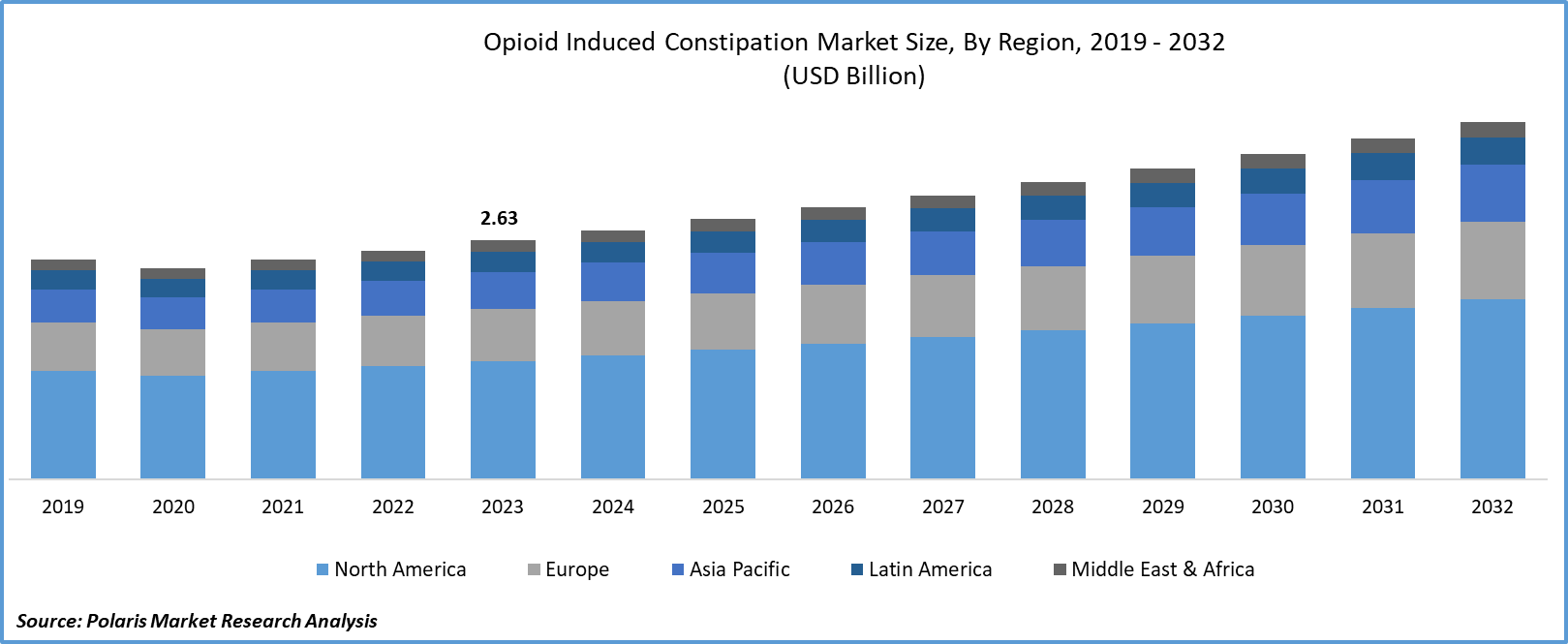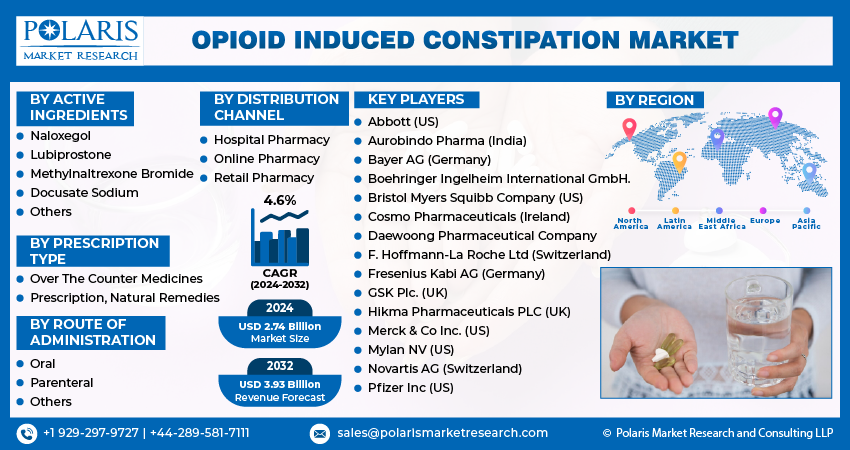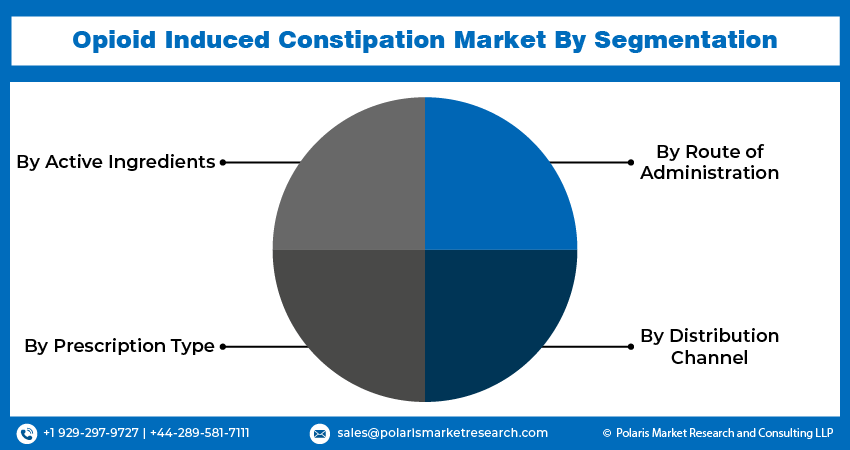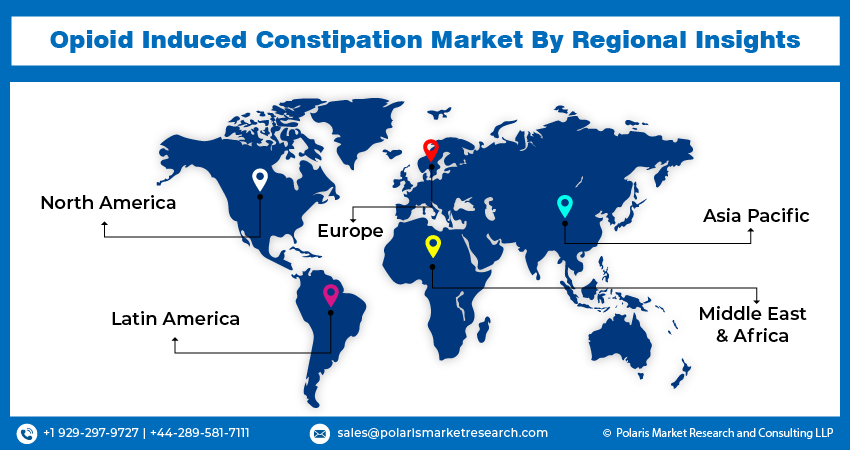
Opioid Induced Constipation Market Share, Size, Trends, Industry Analysis Report, By Active Ingredients; By Prescription Type; By Route of Administration; By Distribution Channel; By Region; Segment Forecast, 2024 - 2032
- Published Date:Jan-2024
- Pages: 116
- Format: PDF
- Report ID: PM4344
- Base Year: 2023
- Historical Data: 2019 – 2022
Report Outlook
Opioid Induced Constipation Market size was valued at USD 2.63 billion in 2023. The market is anticipated to grow from USD 2.74 billion in 2024 to USD 3.93 billion by 2032, exhibiting the CAGR of 4.6% during the forecast period.
Market Overview
Opioid-induced constipation often occurs among the population when they consume opioids, which are mostly consumed to get relief from pain. One of the major causes of constipation with opioid intake is that it lowers the normal function of the digestive system and forces the stool to dry and become hard. It causes staining to the anus muscles, making it hard to relax, necessitating the need for opioid-induced constipation treatment in the marketplace. The ongoing research studies are enhancing the opioid-induced market size in the global market.
For instance, in November 2023, a study published in the Journal of Pain Research focused on testing the ability of methylnaltrexone in treating opioid-induced constipation among critically ill patients and found it was superior in attaining rescue-free luxation in them.

To Understand More About this Research: Request a Free Sample Report
Moreover, apart from the ability of opioids to enhance the quality of life by lessening pain, 18.9% of the patients are showing interest in stopping their use due to their side effects. The significant benefits of opioids, along with their side effects, are driving the potential demand for opioid-induced constipation.
However, the existence of economic painkillers with lesser side-effects and lower knowledge about opioid-induced constipation in the marketplace is likely to hinder the growth of the global market.
Growth Drivers
The Presence of an Elderly Population
The growing geriatric population is significantly facilitating the need for several medications, including pain killers They are more vulnerable to get arthritis, cancer, back pain, and more, thereby consuming opioid-related drugs. As per National Institute on Drug Abuse, nearly 50% of the people in the age threshold of 57 to 85 consume higher than 5 medications, primarily opioids, and benzodiazepines. Additionally, the US population with 55 and more grew by 6% in 2013-2015, while the individual’s taking treatment for opioid-disorders increased by around 54%. One of the major side-effects of having opioids is constipation. The prevalence of higher pain is driving consumption of opioids, thereby, creating demand for medication for opioid-induced health-effects.
The Significant Rise in Opioid Prescriptions
The increasing demand for opioids is expected to contribute to the demand for opioid-induced constipation in the market. For instance, in December 2022, the opioid prescription from surgeons contained around 44 pills, which is normally higher than the patients required after surgery. This trend is expected to positively influence the demand for opioid-induced constipation during the study period.
Moreover, as per World Health Organization, there is a 1040% rise in the opioid induced deaths in between 2013 and 2019 in Americans. This is showcasing the risk of attaining harmful health problems due to the consumption of opioids. The propensity to provide pain relief is a significant factor fuelling its adoption, subsequently causing constipation, and other health issues among the individuals.
Restraining Factors
The Declining Use of Opioids in the Marketplace
Healthcare providers and patients are becoming more vigilant about their treatment procedures and medications with the lower penetration of asymmetry of information in the healthcare industry, driven by growing accessibility to the internet. The increased knowledge about medication side-effects is expected to limit their use by patients, causing lower chance of getting opioid-induced health issues, restraining the opioid-induced constipation market.

Report Segmentation
The market is primarily segmented based on active ingredients, treatment, route of administration, end-users, distribution channel, and region.
|
By Active Ingredients |
By Treatment |
By Route of Administration |
By Region |
|
|
|
|
By Active Ingredients Analysis
Naloxegol Segment is Expected to Witness the Highest Growth During the Forecast Period
The naloxegol segment is projected to grow at a CAGR during the projected period, mainly driven by its safety profile and effectiveness in treating opioid-induced constipation. A 2021 study focused on testing the potential capabilities of naloxegol among patients suffering from opioid-induced constipation. The result showcased its enormous strength of naloxegol in offering treatment to opioid-induced constipation among the cancer patients.
By Treatment Analysis
Prescription Segment Registered for the Largest Market Share in 2023
The prescription segment accounted for the largest market share in 2023 and is likely to retain its market position throughout the forecast period. The limited knowledge about the medicines needed for opioid-induced constipation among the population is likely to drive the necessity of consulting a doctor and taking a prescription around the world.
However, the rising number of internet users is likely to promote the utilization of over-the-counter products in the marketplace, driving their significant adoption in the opioid-induced constipation market over the forecast period.
By Route of Administration Analysis
Oral Segment Held the Significant Market Revenue Share in 2023
The oral segment held a significant market share in revenue in 2023, which is highly accelerated due to the prevalence of having opioid-induced constipation medicine orally. Most of the available medicine to treat this disease is taken orally due to the effectiveness and functionality, driving a significant segmental share in the future.

Regional Insights
North America Region Registered the Largest Share of the Global Market in 2023
The North America region held the dominant share in 2023. This is due to the rising use of painkillers. According to the U.S. Pain Foundation, over 20% of American adults experience chronic pain, and they are most likely to take prescribed pain relief drugs, including opioids, to cope with their pain. The cause of constipation is often one of the side effects of opioid-related painkillers.
The Asia Pacific region is expected to be the fastest growing region with a healthy CAGR during the projected period, owing to the presence of a larger population base and the higher rate of senior citizens in the region. As these people adopt opioid-related painkillers due to their higher efficiency in granting relief from pain, there will be a significant demand in the future. As per National Drug Dependence Treatment Centre, Delhi in 2023, around 10-50% are expected to become addicted to the consumption of opioid drugs for pain relief.

Key Market Players & Competitive Insights
Strategic Collaborations to Fuel the Competition
The opioid-induced constipation market is moderately fragmented. The increased collaborative initiatives are likely to promote competition in the market. For instance, in August 2023, Kyowa Kirin & Grünenthal GmbH entered a collaboration to establish a new venture to offer a combined portfolio of therapeutics, including Moventig, for opioid-induced constipation.
Some of the major players operating in the global market include:
- Abbott (US)
- Aurobindo Pharma (India)
- Bayer AG (Germany)
- Boehringer Ingelheim International GmbH. (Germany)
- Bristol Myers Squibb Company (US)
- Cosmo Pharmaceuticals (Ireland)
- Daewoong Pharmaceutical Company (South Korea)
- Fresenius Kabi AG (Germany)
- F. Hoffmann-La Roche Ltd (Switzerland)
- GSK Plc. (UK)
- Hikma Pharmaceuticals PLC (UK)
- Merck & Co Inc. (US)
- Mylan NV (US)
- Novartis AG (Switzerland)
- Pfizer Inc (US)
Recent Developments in the Industry
- In November 2023, a study published in MDPI explored the use of opioid antagonists in line with dysbiosis and opioid-induced constipation in the present and future.
- In May 2022, a study published in Medical Science explored the effectiveness of itopride in the management of opioid-induced constipation among palliative care patients.
Report Coverage
The opioid induced constipation market report emphasizes on key regions across the globe to provide better understanding of the product to the users. Also, the report provides market insights into recent developments, trends and analyzes the technologies that are gaining traction around the globe. Furthermore, the report covers in-depth qualitative analysis pertaining to various paradigm shifts associated with the transformation of these solutions.
The report provides detailed analysis of the market while focusing on various key aspects such as competitive analysis, active ingredients, treatment, route of administration, end-users, distribution channel, and their futuristic growth opportunities.
Opioid Induced Constipation Market Report Scope
|
Report Attributes |
Details |
|
Market size value in 2024 |
USD 2.74 billion |
|
Revenue forecast in 2032 |
USD 3.93 billion |
|
CAGR |
4.6% from 2024 – 2032 |
|
Base year |
2023 |
|
Historical data |
2019 – 2022 |
|
Forecast period |
2024 – 2032 |
|
Quantitative units |
Revenue in USD billion and CAGR from 2024 to 2032 |
|
Segments covered |
|
|
Regional scope |
|
|
Competitive Landscape |
|
|
Report Format |
|
|
Customization |
Report customization as per your requirements with respect to countries, region, and segmentation. |
FAQ's
key companies in Opioid Induced Constipation Market are Abbott, Aurobindo Pharma, Bayer, Boehringer Ingelheim International
Opioid Induced Constipation Market exhibiting the CAGR of 4.6% during the forecast period.
The Opioid Induced Constipation Market report covering key segments are active ingredients, prescription type, route of administration, distribution channel and region.
key driving factors in Opioid Induced Constipation Market are presence of an elderly population
The global opioid induced constipation market size is expected to reach USD 3.93 billion by 2032
